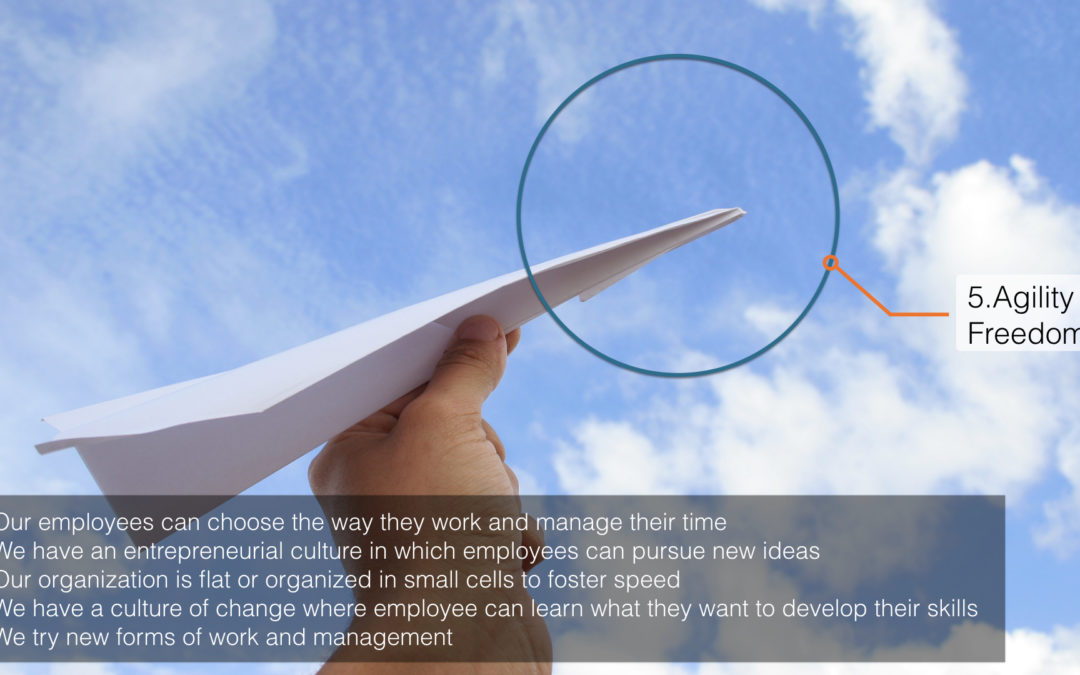According to Benjamin Chaminade, creativity is a four-stage process. The first stage is ‘inspiration’. Therefore, rather than swamp you with different viewpoints and theories, we have decided instead to give you some concrete examples of management innovation practices that have been adopted by companies of different sizes, activities and nationalities. They all have one thing in common: they have succeeded in combining self-fulfilment and performance.
Here are a few innovative practices, ranked in order of importance according to French companies (trust, commitment, wellbeing, agility, collaboration and creativity).
Agility & Freedom
“A company without order is unable to survive, but a company without disorder is unable to evolve”. B. Nadoulek
“Sorry, sir, I am not able to answer your question, the head office makes those decisions and I’m not party to them”, “We’ve always done it like that, why change now?”, “This is Versailles, the staff don’t really have any autonomy. All decisions are taken by the Board of Directors”. Most companies today are still organised according to the good old-fashioned principles of Taylorism, in other words structured according to job type and with a centralised decision-making body, intricately developed job descriptions and strict company procedures governed entirely by those in charge.
What some managers don’t seem to grasp is that while this methodology may be suited to a linear and predictable world, it’s actually counterproductive in today’s complex, constantly evolving and unpredictable society.
100% quality, cost control, risk management….when workplaces are governed by inflexibility, formality (rules, procedures, forms….) and strict monitoring and reporting tools, it may guarantee some kind of conformity, but on the flip side it generates rigid administrative processes that serve no purpose other than to slow down company responsiveness. What’s worse, those who do want to free themselves from these ways of working have no choice but to admit they are helpless in this regard due to the multitude of standards imposed on them, either by the State, their sector or their customers (ISO, procurement contracts, CSR, solvency, Basle agreements…).
Yet the difference between competing companies nowadays is largely based on their ability to be responsive, even proactive. What companies need to do is break free from dated management methods and instead focus on common-sense (by concentrating on value-creation activities), simplicity (by reducing the number of procedures and non-value-adding activities), resourcefulness (by learning to do more with less, being less constrained), structure modification(being either product- or customer-focussed) and staff autonomy (mobile working, home working…). All these things help to drive results, by restoring a sense of worth to the workplace and mobilising staff according to shared values.
Three examples of how you might achieve greater agility and freedom
- In France, following a suggestion by Colonel Marlot, Director of the Saône et Loire Firefighters Centre (2500 employees), a ‘Territorial Intelligence Network’ was set up to help solve problems without a known solution. This ran alongside the company’s organisational structure. The aim of this body was to ‘mobilise the masses’ and enable freedom of expression – consequently, prior to each meeting, attendees would be required to leave their ranks, job titles and any seniority at the door.
- At Semco, in Brazil,(a company with more than 3000 employees), staff are free to determine their own salaries (often above the national minimum wage), to come to work when they want and organise their workload as they wish. In return for this freedom they must guarantee their commitment. Those who don’t will be held to account by the whole company, not just their manager.
- Following an alarming financial situation at the biscuit manufacturer, Poult (France), in 2007, employees took the decision to liberate themselves from certain support functions (time management, stock control) and instead concentrate on working more widely across the company, concentrating their efforts on new value creation. As a result, reporting was simplified and everyone is now free to explore new ideas and share them with colleagues, without the usual managerial or functional constraints.



Recent Comments